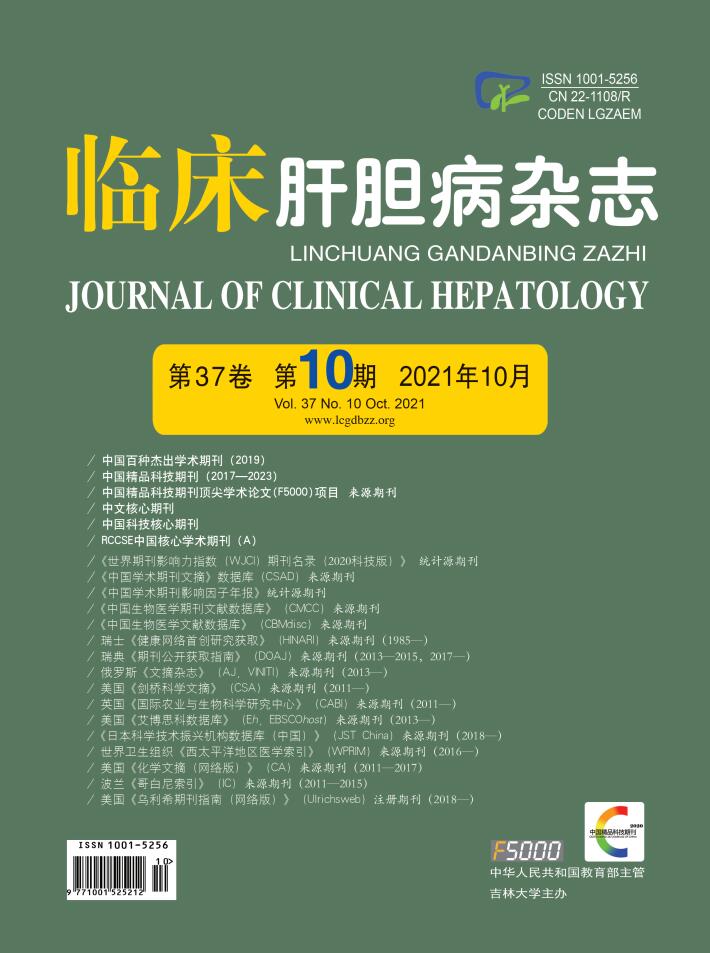| [1] |
COBBINA E, AKHLAGHI F. Non-alcoholic fatty liver disease (NAFLD)-pathogenesis, classification, and effect on drug metabolizing enzymes and transporters[J]. Drug Metab Rev, 2017, 49(2): 197-211. DOI: 10.1080/03602532.2017.1293683. |
| [2] |
National Workshop on Fatty Liver and Alcoholic Liver Disease, Chinese Society of Hepatology, Chinese Medical Association; Fatty Liver Expen Committee, Chinese Medical Doctor Association. Guidelines of prevention and treatment for nonalcoholic fatty liver disease: A 2018 update[J]. J Clin Hepatol, 2018, 34(5): 177-186. DOI: 10.3969/j.issn.1672-5069.2018.02.007. |
| [3] |
CHALASANI N, YOUNOSSI Z, LAVINE JE, et al. The diagnosis and management of non-alcoholic fatty liver disease: Practice Guideline by the American Association for the Study of Liver Diseases, American College of Gastroenterology, and the American Gastroenterological Association[J]. Hepatology, 2012, 55(6): 2005-2023. DOI: 10.1002/hep.25762. |
| [4] |
LIU S, SONG JY, PENG J, et al. Association of serum uric acid/creatinine ratio and metabolic syndrome in euthyroid population[J]. J Hyg Res, 2020, 49(3): 374-380. DOI: 10.19813/j.cnki.weishengyanjiu.2020.03.005. |
| [5] |
National Workshop on Fatty Liver and Alcoholic Liver Disease, Chinese Society of Hepatology, Chinese Medical Association. Guidelines of clinical diagnosis and treatment for nonalcoholic fatty liver disease[J]. Chin Hepatol, 2006, 11(1): 68-70. DOI: 10.3969/j.issn.1008-1704.2006.01.032. |
| [6] |
YOUNOSSI ZM, KOENIG AB, ABDELATIF D, et al. Global epidemiology of nonalcoholic fatty liver disease-Meta-analytic assessment of prevalence, incidence, and outcomes[J]. Hepatology, 2016, 64(1): 73-84. DOI: 10.1002/hep.28431. |
| [7] |
|
| [8] |
MARCUCCILLI M, CHONCHOL M. NAFLD and chronic kidney disease[J]. Int J Mol Sci, 2016, 17(4): 562. DOI: 10.3390/ijms17040562. |
| [9] |
CHEN MY, ZHAO CC, LI TT, et al. Serum uric acid levels are associated with obesity but not cardio-cerebrovascular events in Chinese inpatients with type 2 diabetes[J]. Sci Rep, 2017, 7: 40009. DOI: 10.1038/srep40009. |
| [10] |
LIMA WG, MARTINS-SANTOS ME, CHAVES VE. Uric acid as a modulator of glucose and lipid metabolism[J]. Biochimie, 2015, 116: 17-23. DOI: 10.1016/j.biochi.2015.06.025. |
| [11] |
ALI N, RAHMAN S, ISLAM S, et al. The relationship between serum uric acid and lipid profile in Bangladeshi adults[J]. BMC Cardiovasc Disord, 2019, 19(1): 42. DOI: 10.1186/s12872-019-1026-2. |
| [12] |
AFZALI A, WEISS NS, BOYKO EJ, et al. Association between serum uric acid level and chronic liver disease in the United States[J]. Hepatology, 2010, 52(2): 578-589. DOI: 10.1002/hep.23717. |
| [13] |
KAWAMOTO R, NINOMIYA D, AKASE T, et al. Serum uric acid to creatinine ratio independently predicts incident metabolic syndrome among community-dwelling persons[J]. Metab Syndr Relat Disord, 2019, 17(2): 81-89. DOI: 10.1089/met.2018.0055. |
| [14] |
HWANG IC, SUH SY, SUH AR, et al. The relationship between normal serum uric acid and nonalcoholic fatty liver disease[J]. J Korean Med Sci, 2011, 26(3): 386-391. DOI: 10.3346/jkms.2011.26.3.386. |
| [15] |
MOON SS. Relationship between serum uric acid level and nonalcoholic fatty liver disease in pre- and postmenopausal women[J]. Ann Nutr Metab, 2013, 62(2): 158-163. DOI: 10.1159/000346202. |
| [16] |
SPAHIS S, DELVIN E, BORYS JM, et al. Oxidative stress as a critical factor in nonalcoholic fatty liver disease pathogenesis[J]. Antioxid Redox Signal, 2017, 26(10): 519-541. DOI: 10.1089/ars.2016.6776. |
| [17] |
XU C, WAN X, XU L, et al. Xanthine oxidase in non-alcoholic fatty liver disease and hyperuricemia: One stone hits two birds[J]. J Hepatol, 2015, 62(6): 1412-1419. DOI: 10.1016/j.jhep.2015.01.019. |
| [18] |
SEO YB, HAN AL. Association of the serum uric acid-to-creatinine ratio with nonalcoholic fatty liver disease diagnosed by computed tomography[J]. Metab Syndr Relat Disord, 2021, 19(2): 70-75. DOI: 10.1089/met.2020.0086. |







 DownLoad:
DownLoad: